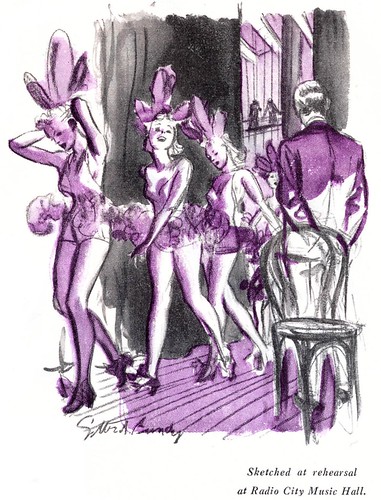
Perhaps the lively sketchiness of the pieces in this breezy series somewhat reflect the style Bundy would employ while working as a combat artist for King Features in the Pacific War Theatre during W.W. II...

Names like Iwo Jima and Okinawa have taken on an almost mythological status in the ensuing decades... Gilbert Bundy was in those places - and many others - during some of the most horrific and brutal fighting.

At one point, the amphtrack in which he was traveling received a direct hit. Every man on board was killed, except Bundy. He spent the next twenty four hours, alive but partially submerged in water, surrounded by the dead, before being recued.

How does one return to a normal life of illustrating the inconsequential after experiencing such a nightmarish existence? Gilbert Bundy never did. Nearly twenty years after these illustrations saw print, Bundy, still haunted by his wartime experiences, committed suicide.
My Gilbert Bundy Flickr set.
Leif:
ReplyDeleteI thought I knew a lot about American illustration history, but every once in a while a fact comes along that absolutely floors me. What an incredible story. He was so talented; in such a breezy, confident way. I've always had the smug notion that life experience serves to inform one's art -- but some experiences simply swamp your life, leaving nothing to hold onto.
He must have liked Degas.The first picture with the "U" dancing figure is just exquisite.
ReplyDeleteHe also was a storyteller.
About the last illustration, the "Radio Music Hall Rehearsal"...well I just fancied Bill looking at Monica...
After reading about the lives of many top illustrators, I have come to the conclusion that the very sensitivity we must have toward our work as illustrators, can also become a liability particularly in war.
ReplyDeleteHarvey Dunn and other combat artists, were forever changed from the carnage they saw in WW 1. Norman Rockwell was was released early from the Navy at the end of WW1, with an "inaptitude discharge". He also suffered throughout his life, from periodic bouts of depression and insecurity as an illustrator. Pruett Carter took his own life along with his adult son's life, in 1955. The reason was a mystery.
Other illustrators had tragic and sad lives, however I think probably most illustrators had typical ups and downs, but truly enjoyed their life as illustrators.
Tom Watson
Very insightful post Leif. When looking back on someone's work, too often we think of them as automatons painting away unaffected by their surroundings or circumstance, but if you've done this for any length of time you realize that you can look back on your work and recall the parallel life you've lived away from your easel...both good and bad. It's easy to remember the paintings you were working on when you fell in love or when your babies were born...when you had to meet a deadline with walking pneumonia or your dad passed away.
ReplyDeleteA touching and tragic reminder of the realities of life.
L
What a moving post. Thank you, Leif. I have admired Bundy's work, but never knew his story. Ronald Searle also comes to mind as a young artist who witnessed (and secretly sketched) the horrors of war as a captive on the Burmese trail, and went on to make great illustrations with a sardonic edge that were surely colored by the things he observed.
ReplyDelete